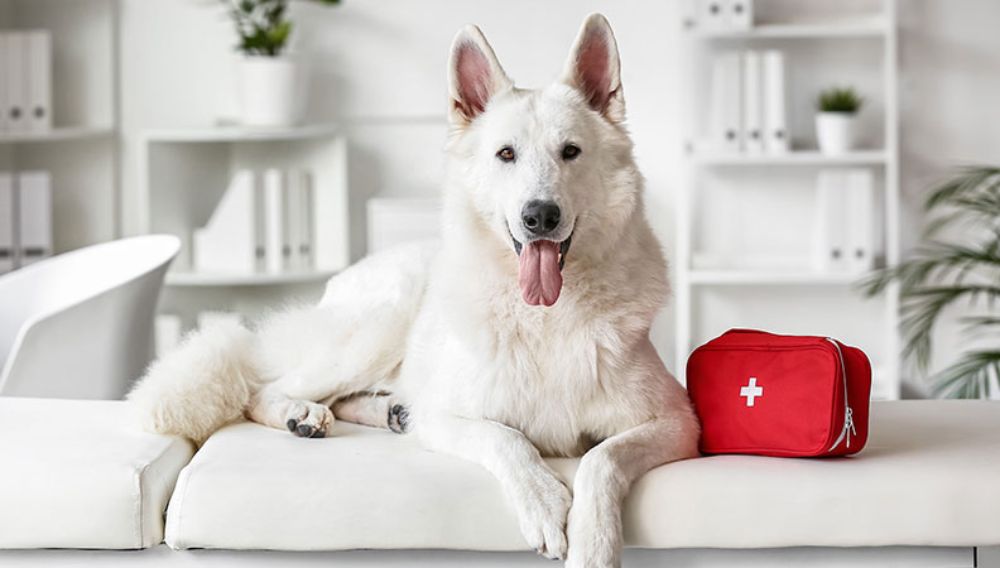
Knowing first aid for dogs may save their life following an accident or illness, but it should never replace professional veterinary treatment. Having a dog first aid kit at home is beneficial for minor injuries. However, what do you do an emergency?
To help we've put together this guide so you can be best prepared if you need to administer first aid. Remember to stay calm, don’t put yourself in danger and ALWAYS contact your vet as soon as possible.
Contents of Your Dog First Aid Kit
Having everything in one dog first aid kit will save time and make for a less stressful situation. Here's what it should include:
- Bandages – self-adhesive or crepe, and conforming/open-weave
- Non-adhesive absorbent dressings
- Surgical sticky tape
- Cotton wool
- Sterile absorbent gauze
- Blunt ended scissors
- An Elizabethan collar
- Blankets and towels
- A foil blanket
- Out of hours vet details
- Taxi numbers in case you need transport
What to do in Emergency Situations
A pet first aid course will help prepare you for an emergency situation involving your pet. Sometimes waiting for a vet could put your dog's life in danger leaving you to give your dog first aid immediately. Below you'll find some emergency dog situations where you could be required to give first aid, and how to to do it.
In an emergency situation, always call your vet as soon as possible for advice and assistance.
My Dog's Not Breathing - Performing Mouth-to-Nose Resuscitation
If your dog's not breathing and you need to perform mouth-to-mouth, in this case mouth-to nose, here's the instructions you need.
- Get someone to call your vet while you give first aid
- Check for a heartbeat and if your dog is conscious
- Grasp their tongue and pull it forward out of their mouth to open the airways
- Check for any blockages in their throat
- Close their mouth and breathe into their nose until their chest expands
- Repeat this every five seconds until the dog regains consciousness or a vet arrives
My Dog has no Heartbeat - Performing CPR

If you can't feel your dog's heartbeat, they may require CPR (Cardio Pulmonary Resuscitation). You have probably seen this on TV, but perhaps never on a dog.
- Get someone to call your vet while you give first aid
- Feel and listen for a heartbeat then lay the dog on its side on a firm surface
- Place one hand over the heart (behind the left front elbow) and the other under the chest for support
- Press down on their heart 100-120 times per minute
- The force you apply depends on the size of the dog
- Alternate between compressions and rescue breaths (hold the mouth closed and breathe into the nose) – 30 compressions, 2 rescue breaths
- Continue to do this until a vet arrives or your feel a heartbeat.
My Dog's Choking
If your dog's having difficulty breathing, pawing excessively at their mouth, making choking sounds, or has blue lips or tongue it’s likely they have a blockage.
Look into your dog’s mouth for a blockage and if you can see it try to gently remove it. Take care not to push it further down or get bitten.
If your dog collapses, or you’re unable to remove the object, lay your dog on their side. Push down quickly and firmly on their tummy just behind their rib cage 3 or 4 times. Repeat until the item dislodges, or your vet arrives.
My Dog has Heat Stroke
If your dog is panting heavily, has difficulty breathing, is drooling excessively, has an increased temperature, reddened gums or a rapid heart rate, it’s likely they’re suffering from heat stroke.
Call your vet immediately and try to cool your dog down. Put a cool damp towel around their body and wet their paws and ear flaps with cool water (not very cold water).
My Dog's Bleeding
If your dog is bleeding, try to keep your dog calm and contact your vet immediately. Stem the bleeding by holding a clean towel over the wound and apply pressure.
Apply an absorbent bandage if you can, but if the wound is in a place that can’t be bandaged, keep the towel pressed firmly onto the wound. Loosen the pressure every 15-20 minutes for 20 seconds to prevent swelling.
My Dog's Been Poisoned
Symptoms of dog poisoning include diarrhoea and vomiting, loss of appetite, seizures, pale gums, unusual behaviour, lethargy or collapse. If you think you know what your dog has eaten, check the label of the product or try to identify the cause. Contact your vet and take the offending item with you to help your vet with fast and effective treatment.
If your dog's suffering from an allergic reaction, their symptoms will be very similar, and you should act in the same way.
My Dog's been Burned
Flush the burn with cold water for at least 5 minutes and contact your vet. Take care not to flush any chemical substances into their eyes. Keep your dog warm on the way to the vets.
My Dog's Having a Seizure
During a seizure a dog will fall on its side, make running movements, lose control of their bladder/bowels, or foam at the mouth. Don’t try to hold or move your pet during a seizure. Darken the room, reduce noise and move any items away from them that may cause harm. When the seizure stops, keep your pet calm and take them to see a vet.
In some situations, there isn’t any first aid that you can administer other than to take your dog to the vet as soon as possible. Following a seizure your dog may go into shock, have internal bleeding, spinal injuries, fractures or broken bones that your vet will need to treat. In all situations, try to keep your dog calm, warm, restrict their movement and take care when transporting them.
What NOT to do in an Emergency Situation
DON'T PANIC or PUT YOURSELF IN DANGER. That is sometimes easier said than done, but being calm and rational will help your dog. Remember, an injured animal may react aggressively, despite their usual placid nature, so rational thinking can be key.
DON'T intervene with fighting dogs as it’s highly likely you will get bitten and you could worsen their injuries.
DON'T jump in to rescue a dog struggling in water as they’re often able to free themselves and are better swimmers than most people. If a dog is drowning and you can safely get them out of the water, hold them upside down to drain the water out and resuscitate them if they’re not breathing.
Do I Need to Take My Dog to the Vet?
Always take your dog to the vet following any first aid as it's likely your dog will need further treatment. If your vet surgery is closed, take your dog to the out of hours practice instead. Most out of hours practices will be further away than your usual practice, so knowing where it is beforehand will help to save valuable time. Always phone ahead and explain the situation!
Knowing first aid for pets can help to save your pet in life threatening situations. The best way to prepare yourself is to complete a dog first aid training course. You'll be able to find first aid training courses for pets locally, or if it's more convenient, there are online courses available.
Having a first aid kit for a dog will make treatment easier. Your dog is most vulnerable in the first 24 hours after an emergency situation, so you should always take them to be checked over by a vet following your first aid treatment.
Everypaw Dog Insurance
Everypaw's Dog Insurance comes with 24/7 unlimited access to vets and vet nurses that can help with your pet's health, care, nutrition and behaviour. So you can rest assured your pup will be well looked after.
Content provided from Vetstream's Vetlexicon Canis - www.vetstream.com/treat/canis
Vetlexicon is the world’s largest peer-reviewed online clinical reference source. All our content is written and peer-reviewed by over 1,000 of the world’s leading veterinarians, ensuring relevance, accuracy and quality.
- Garosi L & Vetstream Ltd (online) Epilepsy (seizures). In: Vetlexicon Canis. Vetstream Ltd, UK. Website: https://www.vetlexicon.com/treat/canis/client-information/epilepsy-(seizures)
- Bates N (online) Poisoning: overview. In: Vetlexicon Canis. Vetstream Ltd, UK. Website: https://www.vetlexicon.com/treat/canis/diseases/poisoning-overview
- Marsella R & Scarff D (online) Skin: burn/scald. In: Vetlexicon Canis. Vetstream Ltd, UK. Website: https://www.vetlexicon.com/treat/canis/diseases/skin-burn-scald
- Vetstream Ltd, Murphy K & Gant P (online) Heat stroke In: Vetlexicon Canis. Vetstream Ltd, UK. Website: https://www.vetlexicon.com/treat/canis/client-information/heat-stroke